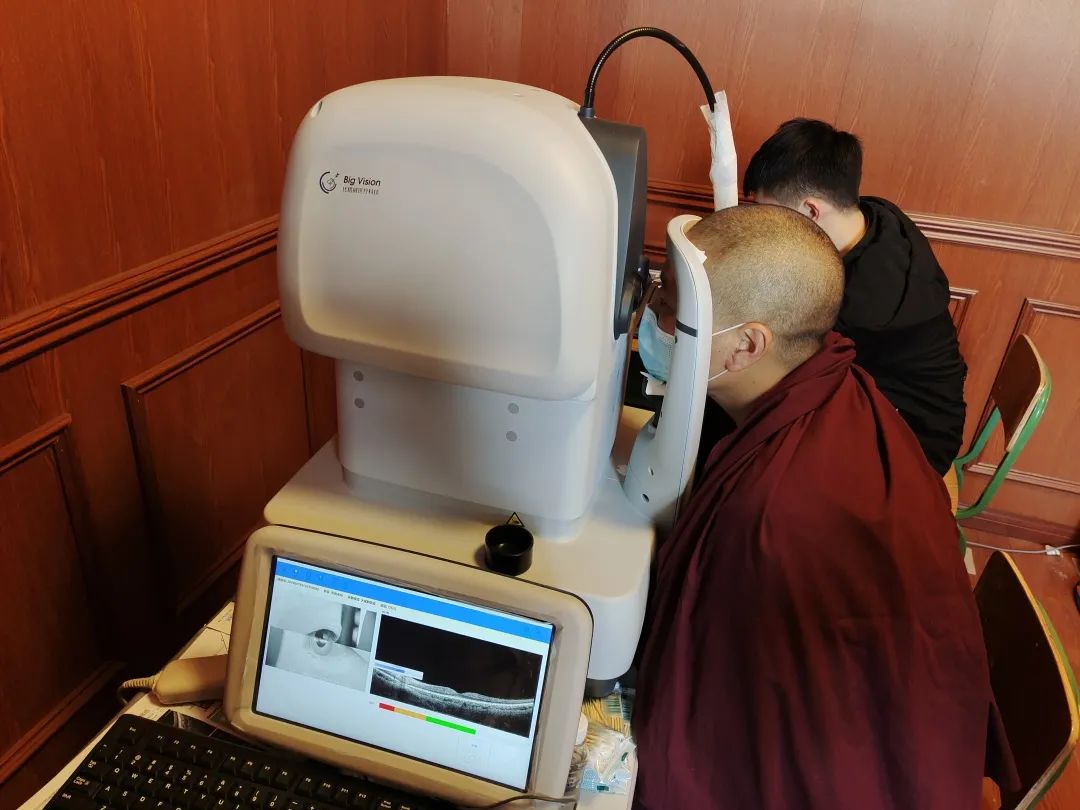This article is reproduced from “VBDATA”

It has been reported by VBDATA that Big Vision Medical, or Big Vision, a company specializing in the research, production and sales of AI-assisted diagnosis systems for ophthalmic imaging, has recently completed Series A+ financing worth tens of millions yuan. The investors are Suzhou High-tech Venture Capital and Nongfu Spring Capital. KaiCheng Capital and Zhiyin Capital will serve as financial advisers. The rapid acquisition of new funding by Big Vision demonstrates recognition and affirmation of investment institutions for the company’s technological advantages and development in the field of ophthalmic AI.
Founded in the Suzhou Industrial Park in 2015, Big Vision focuses on the research, production and sales of AI-assisted diagnosis systems for ophthalmic imaging analysis.
In 2018, Big Vision released MIAS, the first dual-mode ophthalmic imaging AI-assisted diagnosis system in the industry. Currently, it has started testing and certification for three medical device registration certificates. MIAS3000 is expected to be the world’s first OCT ophthalmic imaging-assisted diagnosis system with Class III medical device registration certificate. Big Vision’s self-developed next-generation fully automated AI OCT BV1000 was launched and sold in 2020, and has been applied in nearly a hundred hospitals. In 2021, the landing of BV1000 in hospitals is accelerating, and its sales revenue has exceeded tens of million yuan.

Accurate and convenient multimodal ophthalmic imaging-assisted diagnosis system.
Big Vision Medical has made remarkable achievements in ophthalmic AI technology innovation, applying for more than 70 patents and obtaining more than 30 authorized invention patents. In 2020, it was awarded the first prize of “Wu Wenjun Artificial Intelligence Technology Invention” in China’s artificial intelligence field’s highest award.

Exploring a truly practical AI business path.
Dr. Chen Xinjian, the founder of Big Vision Medical, is a national-level talent, the chief scientist of the Youth 973 Program in the Ministry of Science and Technology, the project leader of the National Key R&D Program. He received his Ph.D. in Pattern Recognition and Intelligent Systems from the Institute of Automation at the Chinese Academy of Sciences. He has conducted research on medical imaging AI at renowned research institutions such as Microsoft Asia Research Institute, University of Pennsylvania, and National Institutes of Health (NIH) in the United States.

In 2012, Dr. Chen Xinjian was awarded the national-level talent title and returned to China to join Suzhou University as a specially-appointed professor and doctoral supervisor. He established the Medical Image Analysis and Processing Laboratory. After achieving fruitful scientific research results, Dr. Chen Xinjian was determined to “write scientific research results on the land of the country.” In 2015, he founded Big Vision Medical Technology and has since been tirelessly working towards AI-empowered ophthalmic diagnosis and treatment.
Compared with MIAS released in 2018, Big Vision’s product form has evolved from algorithm software to a hardware-software integration. This was a strategic choice made by Big Vision Medical based on market demand. The number of eye disease patients in China is huge. With the aging population, age-related, metabolic, and highly myopic related retinal diseases have become the leading cause of irreversible blindness in China, accounting for 54.7% of all blind patients.
Due to the low public awareness of retinal diseases and insufficient and uneven allocation of primary eye care medical resources, currently only 10% of retinal disease patients receive standardized treatment. Many retinal disease patients’ conditions have advanced to late stages when seeking medical attention, missing the best treatment window. Early screening and adequate standardized treatment of retinal diseases can effectively save patients’ vision and change their treatment outcomes.
OCT is the authoritative inspection equipment for clinical diagnosis and treatment of retinal diseases. However, the traditional OCT operation process is complex, and image interpretation relies on highly qualified professionals, limiting OCT’s popularization and application at the primary level. The effective way to solve the insufficient primary eye care medical resources in China is to use advanced ophthalmic AI technology to empower doctors.

The fully automatic artificial intelligence OCT developed by Big Vision has achieved automatic pupil positioning and focusing, reducing the likelihood of unsuccessful shots due to manual operation incompetence. Through closely connected voice prompts with the examination process, it reduces the workload of guiding operators and provides a more friendly experience for patients. The device integrates Big Vision’s industry-leading ophthalmic AI algorithm, which accurately identifies and automatically labels disease lesion areas, providing valuable diagnostic and therapeutic information for primary ophthalmologists. The fully automatic artificial intelligence OCT BV1000 developed by Big Vision Medical allows primary ophthalmologists to have a truly usable OCT.

In July 2021, Big Vision Medical supported the “Chuan Zang Qing Guangming Project Tashikuangmingxing” public welfare screening organized by Wenzhou Medical University. More than 2,000 Tibetans received fundus examinations, with a record of 281 people examined on one day. The fast, efficient, and stable performance of BV1000 was fully tested and received unanimous praise from the medical team leader, doctors, and Tibetan compatriots.

After more than a year of market promotion, the landing of Big Vision Medical’s BV1000 in hospitals has been accelerating. Currently, it has been applied in nearly 100 hospitals, including Wenzhou Medical University Affiliated Eye Hospital, Zhongshan Ophthalmic Center, Longchuan County People’s Hospital, Yangxi County People’s Hospital, and Xi’an Metallurgical Hospital.

Through a software and hardware integrated product technology route, Big Vision’s fully automatic artificial intelligence OCT provides a complete solution for primary ophthalmology clinics and ophthalmology medical consortia. AI empowers the equipment hardware, while the equipment hardware provides data interfaces for AI, driving each other for the highlighting of product advantages.
With the successful development of the fully automatic artificial intelligence OCT, Big Vision Medical has established a professional and highly efficient technical team, accumulating rich experience in the development of ophthalmic equipment software and hardware. Big Vision is laying out a full line of intelligent ophthalmic examination equipment and rapidly advancing the series development of AI ophthalmic hardware such as AI visual acuity screening instruments, AI dry eye analyzers, AI biometric instruments, and AI corneal topography.
MIAS 3000 is expected to become the world’s first class III medical device registered ophthalmic OCT image-assisted diagnostic system.
As an innovative company deeply focused on ophthalmic AI, Big Vision has taken a differentiated approach from the beginning. While most ophthalmic AI products on the market are based on fundus color photography for diabetic retinopathy diagnosis, Big Vision Medical has conducted research on OCT images for ophthalmic AI and developed mature products.
Fundus color photography provides a two-dimensional image of the retina, while OCT captures three-dimensional structural information of the retina. The complexity and difficulty in developing AI algorithms for OCT images are greater than that for fundus color photography. Big Vision Medical has continuously researched and applied classification, identification, and lesion segmentation algorithms for over ten types of fundus diseases, such as age-related macular degeneration (AMD), using OCT images. They have achieved a series of innovative results and obtained over 70 patent applications and more than 30 authorized invention patents in this field.

Dr. Chen Xinjian told VBDATA that one of the successful experiences of Big Vision Medical’s technological innovation is to conduct extensive and in-depth collaborative innovation with universities and ophthalmic medical institutions. In 2016, Big Vision Medical and Suzhou University jointly established the “Suzhou University-Big Vision Medical Joint R&D Laboratory,” which jointly applied for and participated in national key research and development projects. They fully utilized the advantages of university research resources to continuously improve product research and development, talent training, and team building, and accelerate the pace of scientific research achievements transformation.

Active cooperation with well-known national ophthalmic medical institutions such as Zhongshan Ophthalmic Center of Sun Yat-sen University, Beijing Tongren Eye Center, Shanghai First People’s Hospital, and Wenzhou Medical University Affiliated Eye Hospital has brought rich real-scenario demands and topics for Big Vision Medical’s ophthalmic AI.
In terms of imaging types, Big Vision Medical’s ophthalmic AI research not only covers OCT and fundus color photography but also includes fluorescein angiography, corneal confocal microscopy, slit lamp imaging, and corneal topography. In terms of disease types, it covers age-related macular degeneration (AMD), diabetic retinopathy, glaucoma, high myopia, central serous chorioretinopathy, retinopathy of prematurity (ROP), corneal nerve disease, keratoconus, corneal ulcer, ocular trauma, and other diseases.
Big Vision Medical’s research in ophthalmic AI is comprehensive and has always been at the forefront of the industry. Their technology is at the international advanced level and they have published more than 100 papers in international authoritative journals in related fields, such as IEEE TMI, IEEE TIP, and IOVS. Dr. Chen Xinjian co-authored a specialized book on ophthalmic imaging research titled “Retinal Optical Coherence Tomography Image Analysis,” which was published by the world-renowned science and technology academic publisher, Springer.

MIAS and BV1000, developed by Big Vision Medical, were successively awarded the “Jiangsu Province Excellent Artificial Intelligence Products” honor, and the company won the Jiangsu Provincial Science and Technology Second Prize in 2019. In order to meet the development needs of the artificial intelligence medical device industry, the National Medical Products Administration established a technical unit for standardizing artificial intelligence medical devices in 2019. Big Vision Medical was one of the first members to join the technical unit and participated in the review of relevant standards for artificial intelligence medical devices.
In 2020, the jointly completed project “Intelligent Medical Image Analysis and Clinical Diagnosis Application” by Big Vision Medical won the first prize of the “Wu Wenjun Artificial Intelligence Technology Invention Award.” The Wu Wenjun Artificial Intelligence Science and Technology Award, initiated by the Chinese Association for Artificial Intelligence, is known as the “highest award for intelligent science and technology in China.”

The “Wu Wenjun Artificial Intelligence Technology Invention Award” first prize
This is also the first time in the ten-year history of the Wu Wenjun Artificial Intelligence Science and Technology Award that the first prize has been awarded to medical imaging AI.
Currently, Big Vision Medical’s ophthalmic OCT image-assisted diagnosis software, MIAS3000, has initiated the detection and certification work for three types of medical device registration certificates. It is expected to become the world’s first ophthalmic OCT image-assisted diagnosis system with a three-class medical device registration certificate.
To assist in managing the eye health of citizens throughout their entire life cycle.
In Dr. Chen Xinjian’s vision, Big Vision Medical’s product layout not only includes AI algorithms and intelligent hardware, but in the future eye health ecosystem, the connected and shared cloud platform will play an even more fundamental role.
The eye is the most sophisticated organ in the human body and there are a variety of eye examination devices that generate more image data than many other specialties. At the same time, eye health covers a person’s entire life cycle, with different areas of focus at different ages. Currently, many ophthalmic examination devices still operate as data islands, with examination data being published for scientific research and conference sharing but lacking other means of use, often leading to a large amount of valuable medical data being wasted after the expiration of the device’s use.
Dr. Chen Xinjian told ArteryNet, “In the digital age, I agree with the view of Dr. Wang Jian, the founder of Alibaba Cloud, that data will become a more important resource than land. The role of data in the digital age is equivalent to that of electricity in the age of electricity.”
Data can only be mined and its maximum value realized when it is connected. To this end, Big Vision Medical has built a unified eye health cloud platform architecture and data interface, enabling integration with over 30 different devices from various manufacturers including fundus cameras, corneal topography maps, biometric instruments, slit lamps, refraction meters, and visual screening instruments. End-users can view their historical check-up data and images in their WeChat eye health file at any time, while medical institutions can also track the long-term eye health of end-users.

The establishment of big data in ophthalmic healthcare will play a crucial role in predicting disease progression, evaluating treatment outcomes, and developing new therapeutic approaches.
In 2018, General Secretary Xi Jinping issued important instructions on the prevention and control of myopia in children and adolescents. The Ministry of Education, the National Health Commission, and eight other departments jointly issued the “Comprehensive Implementation Plan for the Prevention and Control of Myopia in Children and Adolescents,” raising the prevention and control of myopia in children and adolescents to a national strategy.
Optometry clinics and vision centers have played an important role in the prevention and control of myopia in children and adolescents. However, many vision centers have transformed and upgraded from traditional eyewear stores and face shortcomings in terms of personnel, professional expertise, and examination equipment. They require comprehensive technological platforms for support. Big Vision Medical has developed the Bright Lemon Eye Health Management Platform, which integrates ophthalmic expertise knowledge graphs and assists in standardizing diagnostic and treatment processes at vision centers. It has been successfully implemented in over ten vision centers, including Xijian Eye Clinic in Nantong and Zhongyi Eye Clinic in Shaoxing.


Panzhihua Daguangming Eyeglasses Co., Ltd., established in 1986, is a highly renowned and influential company in the national optometry industry. After experiencing Big Vision Medical’s products, Panzhihua Daguangming Eyeglasses became the first company in the optometry industry to introduce fully automated AI OCT technology.
Mr. Xue Kejun, Chairman of Daguangming Eyeglasses, believes that when many patients with eye diseases notice vision loss or blurry vision, they usually go to optometry centers for examinations. As a veteran in the optometry industry, he does not want to see any patient with eye diseases being overlooked. This is also the original intention of Big Vision Medical, which is to detect every pair of problematic eyes as early as possible and provide the best treatment plans.
The completion of this round of financing will provide new impetus for Big Vision Medical to accelerate the market launch of its products.
Zhou Zhongqiang, the person in charge of Sugaoxin Venture Capital JinGu Capital, one of Big Vision’s investors, stated that Big Vision Medical is at the forefront of the ophthalmic AI field. Its integrated hardware and software product roadmap provides a comprehensive solution for grassroots optometry. The market has preliminarily validated the truly feasible AI commercial model of Big Vision Medical.
Xu Hua, the person in charge of Nongfa Capital, another investor of Big Vision, mentioned that combining Big Vision’s data advantages with the profound expertise of Dr. Chen Xinjian, the founder, in the field of AI diagnosis of fundus diseases, gives Big Vision obvious technological advantages in the ophthalmic AI field. It has tremendous potential and room for future development.









No comments yet.